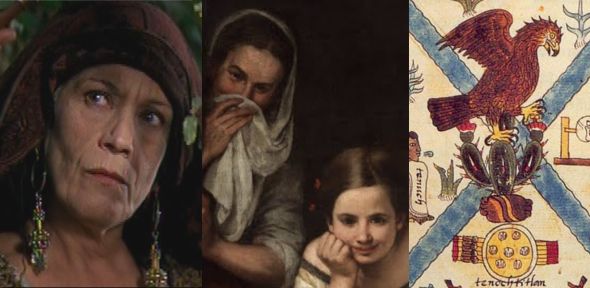
Paper SP3: Literatures and Cultures of Medieval Iberia, Early Modern Spain and Latin America
War and the Hero
Set texts
Gonzalo de Berceo, Vida de Santo Domingo de Silos (Madrid: Castalia, 1981) OR in Brian Dutton, ed., Obras completas, IV (London: Tamesis, 1978).
Libro de Alexandre, ed. Jesús Cañas Murillo (Madrid: Cátedra, 1988) OR Ed. & trans. as Book of Alexander, Richard Rabone & Peter Such (Warminster: Aris & Phillips, 2009) OR ed. Jorge García López (Barcelona: Crítica, 2010).
Poema de Fernán González, ed. Juan Victorio (Madrid: Cátedra, 1981).
Suggested Introductory Secondary Readings
Bowra, CM, Heroic Poetry (London: MacMillan, 1964).
Hazbun, Geraldine, Treacherous Foundations: Betrayal and Collective Identity in Early Spanish Epic, Chronicle, and Drama (Woodbridge: Tamesis, 2009), chapter 2.
——, Narratives of the Islamic Conquest from Medieval Spain (New York: Palgrave Macmillan, 2015), chapter 3.
Kelly, Douglas, ‘The Scope and Treatment of Composition in Twelfth and Thirteenth-Century Arts of Poetry’, Speculum, 41 (1966), 261-78.
Lappin, Anthony, Gonzalo de Berceo: The Poet and His Verses (Woodbridge: Tamesis, 2008)
Michael, Ian, The Treatment of the Classical Material in the ‘Libro de Alexandre’ (Manchester: UP, 1970).
Segal, Robert A., ed. In Quest of the Hero: The Myth of the Birth of the Hero; The Hero: A Study in Tradition, Myth, and Drama, Part II; The Hero Pattern and the Life of Jesus (Princeton, NJ: Princeton UP, 1990).
Uría, Isabel, Panorama crítico del ‘mester de clerecía’ (Madrid: Castalia, 2000).
Weiss, Julian, The ‘Mester de Clerecía’: Intellectuals and Ideologies in Thirteenth-Century Castile (Woodbridge: Boydell & Brewer, 2006), 109-42.
The Great Romance
Set texts
Ana Caro, Valor, agravio y mujer, ed. Lola Luna (Madrid: Castalia 1993).
Miguel de Cervantes, Los trabajos de Persiles y Sigismunda, ed. Carlos Romero Muñoz (Madrid: Cátedra, 2002).
Garcilaso de la Vega, Obra poética y textos en prosa, ed. Bienvenido Morros (Barcelona: Crítica, 1995).
Agustín Moreto, El lindo don Diego, ed. Frank P. Casa and Berislav Primorac (Madrid: Cátedra, 1987).
Lope de Vega, Rimas humanas y divinas del licenciado Tomé de Burguillos, ed. Macarena Cuiñas Gómez (Madrid: Cátedra, 2008).
Suggested Introductory Secondary Readings
Butler, J., Gender Trouble: Feminism and the Subversion of Identity (New York-London: Routledge, 1999).
Forster, L. W., The Icy Fire: Five Studies in European Petrarchism (Cambridge: Cambridge UP, 1969).
Laqueur, T., Making Sex: Body and Gender from the Greeks to Freud (Cambridge and London: Harvard UP, 1990).
McKendrick, M., Woman and Society in the Spanish Drama of the Golden Age: A Study of the 'mujer varonil' (Cambridge: Cambridge UP, 1974).
Parker, A. A. The Philosophy of Love in Spanish Literature, 1480-1680 (Edinburgh: Edinburgh University Press, 1985).
Thacker, J., A Companion to Golden Age Theatre (Woodbridge: Tamesis, 2007).
Wilson, D. de Armas, Allegories of Love: Cervantes’s ‘Persiles and Sigismunda’ (Princeton: Princeton UP, 1991).
Playing the Devil
Set texts
Pedro Calderón de la Barca, El mágico prodigioso, ed. Bruce W. Wardropper (Madrid: Cátedra, 1987).
Miguel de Cervantes, El licenciado Vidriera and El casamiento engañoso y Coloquio de los perros, in Novelas ejemplares, ed. Jorge García López (Madrid: RAE, 2013).
Tirso de Molina, El condenado por desconfiado, ed. Ciriaco Morón (Madrid: Cátedra, 1992).
Francisco de Quevedo, Sueño del infierno and Alguacil endemoniado, in Los Sueños, ed. Ignacio Arellano (Madrid: Cátedra, 1996).
Luis Vélez de Guevara, El Diablo Cojuelo, ed. Ramón Valdés (Barcelona: Crítica, 1999).
María de Zayas, El jardín engañoso, in Novelas amorosas y ejemplares, ed. Julián Olivares (Madrid: Cátedra, 2000); and La perseguida triunfante in Desengaños amorosos, ed. Alicia Yllera (Madrid: Cátedra, 1983).
Suggested Introductory Secondary Readings
Boyd, S. (ed.), A Companion to Cervantes’s ‘Novelas ejemplares’ (Woodbridge: Tamesis, 2005).
Cilveti, A. L., El demonio en el teatro de Calderón (Valencia: Albatros, 1977).
Clamurro, W. H., Beneath the Fiction: The Contrary Worlds of Cervantes’s ‘Novelas ejemplares’ (New York: Peter Lang, 1997).
Fernández Rodríguez, N., El pacto con el diablo en la comedia barroca (Oviedo: Universidad de Oviedo, 2007).
Greer, M. R., María de Zayas Tells Baroque Tales of Love and the Cruelty of Men (University Park: Pennsylvania State UP, 2000).
Iffland, J., Quevedo and the Grotesque, 2 vols. (London: Tamesis Books, 1978-1982).
Messadié, Gérald, The History of the Devil; trans. M. Romano (London: Newleaf, 1996).
Muchembled, R., A History of the Devil: From the Middle Ages to the Present (Oxford: Polity, 2003).
Peale, C. G., La anatomía de ‘El diablo Cojuelo’: deslindes del género anatomístico (Chapel Hill: UNCP, 1977).
Sullivan, Henry W. ‘The Cultural and Intellectual Background of Spain in the Counter Reformation’, Tirso de Molina & the Drama of the Counter Reformation (Amsterdam: Rodopi, 1976), pp. 13-70.
Writing the Conquest of Mexico
Set texts
- Hernán Cortés, Cartas de relación (Mexico City: Editorial Porrúa, 2004).
- Sahagún, Bernardino de, “Libro Doceno”, in Historia general de las cosas de Nueva España, ed. A. Garibay (México City: Porrúa, 1956, 1981, 2013).
- Sahagún, Bernardino de, General History of the Things of New Spain: The Florentine Codex. [Manuscript] (Mexico, 1577). World Digital Library. The Library of Congress. [Book XII] https://www.wdl.org/en/item/10623/#institution=laurentian-library
- Manuscrito del aperreamiento, Bibliothèque Nationale de France. https://gallica.bnf.fr/ark:/12148/btv1b10508374m/f4.item
- Bartolomé de las Casas, Brevísima relación de la destruición de las Indias, ed. A. Saint-Lu (Madrid: Cátedra, 2001).
- Bernal Díaz del Castillo, Historia verdadera de la conquista de la Nueva España. (Mexico City: Editorial Porrúa, 2017). [chapters 1-2, 18, 27-29, 36-37, 42-43, 58-65, 78, 81-102, 107-108, 125-129, 207-214]
Secondary texts
- Pagden, Anthony, ‘Introduction’, in Hernán Cortés, Letters from Mexico, ed. and trans. A. Pagden (New Haven: Yale Nota Bene, 2001), xxxix-lxxi.
- Townsend, Camilla, “Introduction,” “Strangers to Us People Here (1519),” and “A War to End All Wars (1520-1521),” in Fifth Sun. A New History of the Aztecs (New York: Oxford University Press, 2019), 1-12; 85-106; 129-154.
- Magaloni Kerpel, Diana, The Colors of the New World: Artists, Materials, and the Creation of the Florentine Codex (Los Angeles: Getty Research Institute, 2014), 1-59.
- Terraciano, Kevin, “Reading Between the Lines of Book 12,” in The Florentine Codex: An Encyclopedia of the Nahua World in Sixteenth-Century Mexico, ed. Janet Favrot Peterson and Kevin Terraciano (Austin: University of Texas Press, 2019), 45-62.
- Boornazian Diel, Lori, “Manuscrito del aperreamiento (Manuscript of the Dogging): A “Dogging” and Its implications for Early Colonial Cholula.” Etnohistory 58:4 (Fall 2011), 585-611.
- Adorno, Rolena, [chapters 3, 4, and 6] “Fray Bartolomé de las Casas, Polemicist and Author,” “Councilors Warring at the Royal Court,” and “The Encomendero and His Literary Authority,” in The Polemic of Possession in Spanish American Narrative (New Haven: Yale University Press, 2007), 61-98, 99-124, 148-171.
Race, Place and Society
Secondary reading
Brann, R., ed., Languages of Power in Islamic Spain (Bethesda: CDL, 1997).
Catlos, Brian A., Kingdoms of Faith: A New History of Islamic Spain (London: Hurst, 2018).
Collins, R., The Arab Conquest of Spain, 710-797 (Oxford: Blackwell, 1989).
Constable, Olivia Remie, Trade and Traders in Muslim Spain: The Commercial Realignment of the Iberian Peninsular, 900-1500, Cambridge Studies in Medieval Life & Thought, 4th ser. (Cambridge: UP, 1994).
*Edwards, John, The Spanish Inquisition (Brimscombe Port: Tempus, 1999.
Elliott, J. H., Europe Divided, 1559-1598, 2nd edn (Oxford: Blackwell, 2000.
* Netanyahu, B., The Origin of the Inquisition in Fifteenth-Century Spain, 2nd edn (New York: Random House, 2001.
Roth, Norman, Jews, Visigoths, and Muslims in Medieval Spain: Co-operation and Conflict, Medieval Iberian Peninsula, 10 (Leiden: Brill, 1994).
——, Conversos, Inquisition and the Expulsion of the Jews from Spain (Madison: Univ of Wisconsin P, 1995).
Fletcher, RA, Moorish Spain (London: Weidenfeld & Nicolson, 1992.
*Glick, T. F. Islamic and Christian Spain in the Early Middle Ages (Princeton: UP, 1979).
Harvey, L.P., Islamic Spain, 1250-1500 (Chicago: Univ. of Chicago P., 1990).
——, Muslims in Spain, 1500-1614 (Chicago: Univ. of Chicago P., 2005).
Ibn Hazm, Tawq 'al-hamamah fi 'al-'ulfah wa-'al-'ullaf (in various translations in the UL as, The Dove’s Neck-Ring, or The Ring of the Dove, or El collar de la paloma)
Kennedy, Hugh, Muslim Spain and Portugal: A Political History (London: Longman, 1996).
Mann, Vivian B., Thomas F. Glick, & Jerrilyn D. Dodds, ed., Convivencia: Jews, Muslims and Christians in Medieval Castile (New York: Baziller & the Jewish Museum, 1992).
Menocal, María Rosa, The Arabic Role in Medieval Literary History: A Forgotten Heritage (Philadelphia: Univ. of Pennsylvania Press, 1987).
Reilly, B. F. The Contest of Christian and Muslim Spain, 1031-1157 (Oxford: Blackwell, 1992).



